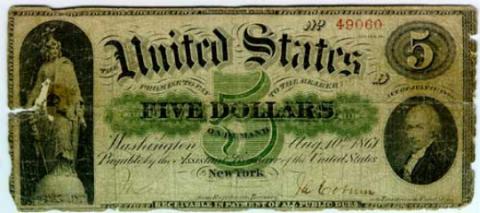The first paper currency in the new world colonies was issued in 1690 by the Massachusetts Bay Colony. Other colonies soon issued their own currency. Of course, counterfeiting was soon to follow as an issue. In 1739, Benjamin Franklin first addressed the problem of counterfeiting. He used his Philadelphia printing presses to print paper currency with nature prints using raised patterns cast from actual leaves. Franklin printed notes for Pennsylvania, Delaware, and New Jersey.
The first $2 currency notes were called Continentals. They were issued on June 25, 1776, by the Continental Congress as “bills of credit” for the defense of America.
Between the Revolutionary and Civil Wars there was no federal currency. Between 1790 and 1865 an estimated 8,000 private organizations, including states, private banks, railroad companies, stores, churches, and even individuals, issued their own paper money. Much of this currency was counterfeit and the redeeming institution most often discounted the face value as much as fifty percent as a hedge against any loss.
Alexander Hamilton, the first Secretary of the Treasury, established the Bank of the United States to create a system of credit for the government in 1791. The bank was the first of several in the country to issue private currencies to facilitate borrowing and lending.
To finance the Civil War, Congress authorized the U.S. Department of the Treasury to issue non-interest-bearing Demand Notes in denominations of 5, 10 and 20 in 1861 and 62. These notes earned the nickname “greenbacks” because of the green ink on the back of the notes.
The currency system became a little less complicated when the National Banking Act of 1863 created a uniform national currency in the form of national bank notes. These national bank notes were issued by nationally chartered banks and were seen as low risk for consumers because they were backed by U.S. government bonds. These “Legal Tender notes” replaced Demand Notes which the holder could take to one of seven banks in the U.S. and demand payment in gold or silver. The Treasury Seal was added to these new notes. The seal design has evolved over the years but still contains a key, scales, and stars.
Two years later the Secret Service was established to deter counterfeiters and solidify public confidence in the nation’s currency.
The Federal Reserve Act of 1913 established the Federal Reserve as the nation’s central bank and provided for a national banking system that was more responsive to the fluctuating financial needs of the country. The Federal Reserve Board issued a new currency called Federal Reserve notes.
The Federal Reserve Board issued the $10,000 note in 1918. This note was intended for bank-to-bank large value transfers, not public circulation. A picture of Salmon P. Chase, a former Secretary of the Treasury, graces the note.
The United States added unique serial numbers to banknotes in 1928 and an automobile was added in front of the Treasury building image. The next year the Treasury reduced printing costs by reducing the size of the federal notes and standardized the design for each note.
A $2 note, with Thomas Jefferson on the front of the note, was reintroduced in 1976 to commemorate Jefferson’s birth and it is still legal tender.
2023 will mark another first in U.S. currency when the first bills signed by two women, U.S. Treasurer Lynn Malerba, the first Native American in that position, and Treasury Secretary Janet Yellen, will be put into circulation.
Currency Tidbits:
- Forty-five percent of the notes printed by the US Treasury Department are the one-dollar bill.
- Crane and Co., a Massachusetts-based company, has been providing the U.S. Bureau of Engraving and Printing with the specialized paper for U.S. currency since 1879.
- Federal Reserve notes are a blend of 25 percent linen and 75 percent cotton. The currency paper has tiny red and blue synthetic fibers of various lengths evenly distributed throughout the paper.
- It would take 4,000 double folds (forwards and backwards) to tear a banknote.
- No matter the denomination, a banknote weighs approximately 1 gram. Because there are 454 grams in one pound, this means there are 454 notes in one pound of currency.
- Want to measure your notes in a different way? A stack of currency one mile high would contain more than 14.5 million banknotes.
- It is estimated that between one-half to two-thirds of the value of all U.S. currency in circulation is outside of the U.S.
- In 1934, the $100,000 Gold Certificate, with a portrait of President Woodrow Wilson, became the highest denomination ever issued. It was never intended for public use. Instead, it was meant solely for official transactions between Federal Reserve Banks.
- As of December 31, 2020, there was over two trillion dollars’ worth of notes in circulation, totaling 50.3 billion individual notes in volume.
Check out uscurrency.gov for information on how you can feel, tilt, and check your currency to see if the notes are genuine.

